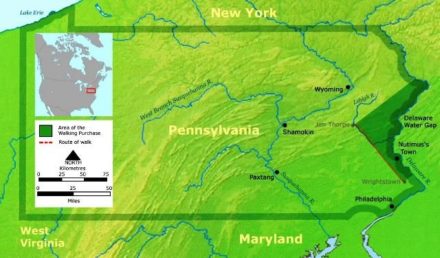
The Walking Purchase
The Walking Purchase, also known as the Walking Treaty, began in the early hours of September 19, 1737, when three colonists and three Native Americans set off to measure out a land purchase that Thomas Penn, son of William, claimed his father had made with the Lenape tribe (also known as the Delaware) fifty years previous. Thomas held in his hand what he said was a deed signed by Lenape chiefs in 1686 that sold all land north of Tohickon Creek on the Delaware River to William Penn. The document stated that the amount of land would be measured by a day and a half’s walk from an agreed upon starting point. The Lenape questioned the validity of the document, yet, in the end they had no choice but to participate.
The “walk” became a race, with the three well-trained Englishmen sprinting as fast as they could. The runners were aided by settlers who cut away underbrush, arranged for horses to carry supplies, and lent boats to ferry the men across streams. They did everything they could to ensure Penn’s men triumphed. In the end, 1.2 million acres were taken from the Lenape and given to the Penn family.
The Lenape were understandably upset and went to the Iroquois for help, but to no avail. Those who stayed in the area were forced to settle on poor land or work as laborers for the colonists. Most decided to move west to places along the Susquehanna, Allegheny, or Ohio rivers. During the French and Indian War they used the Walking Purchase as one of their grievances.
You can download a free book about The Walking Purchase here. And there is a historical marker describing the event, in Ottsville along PA 611.
